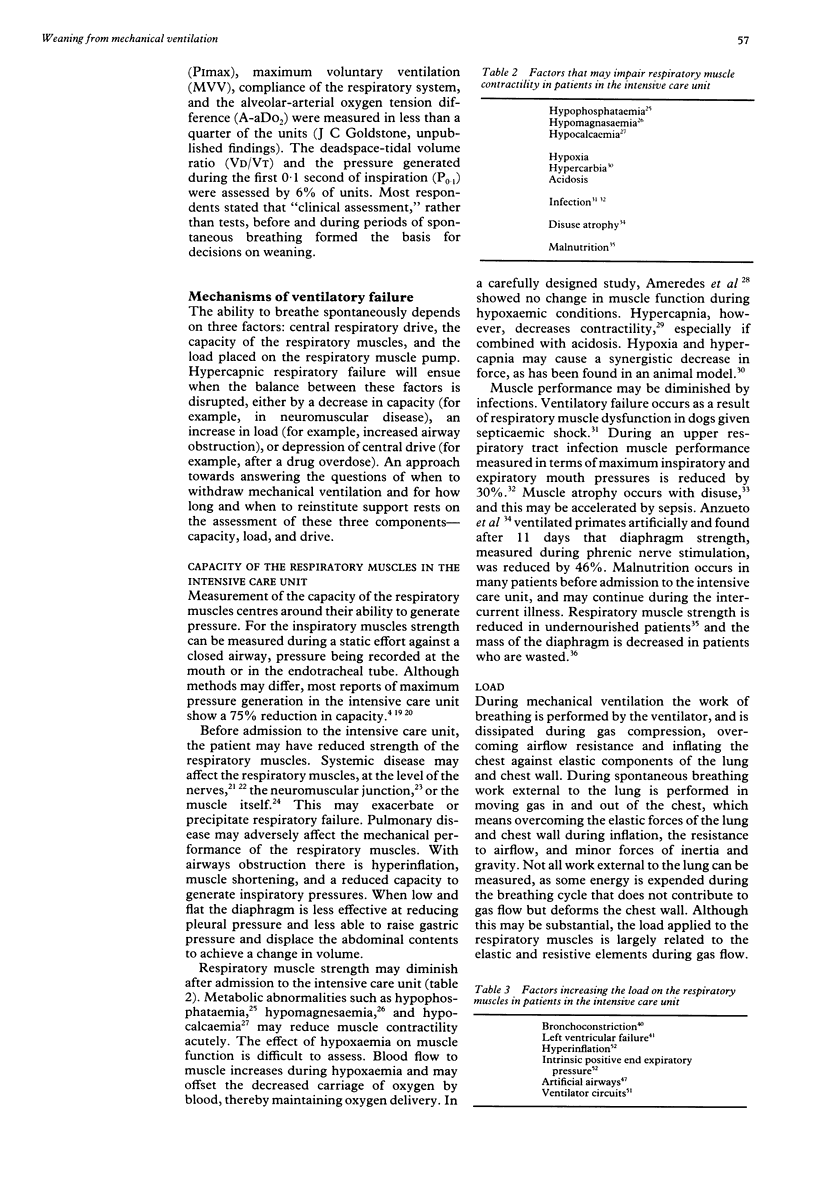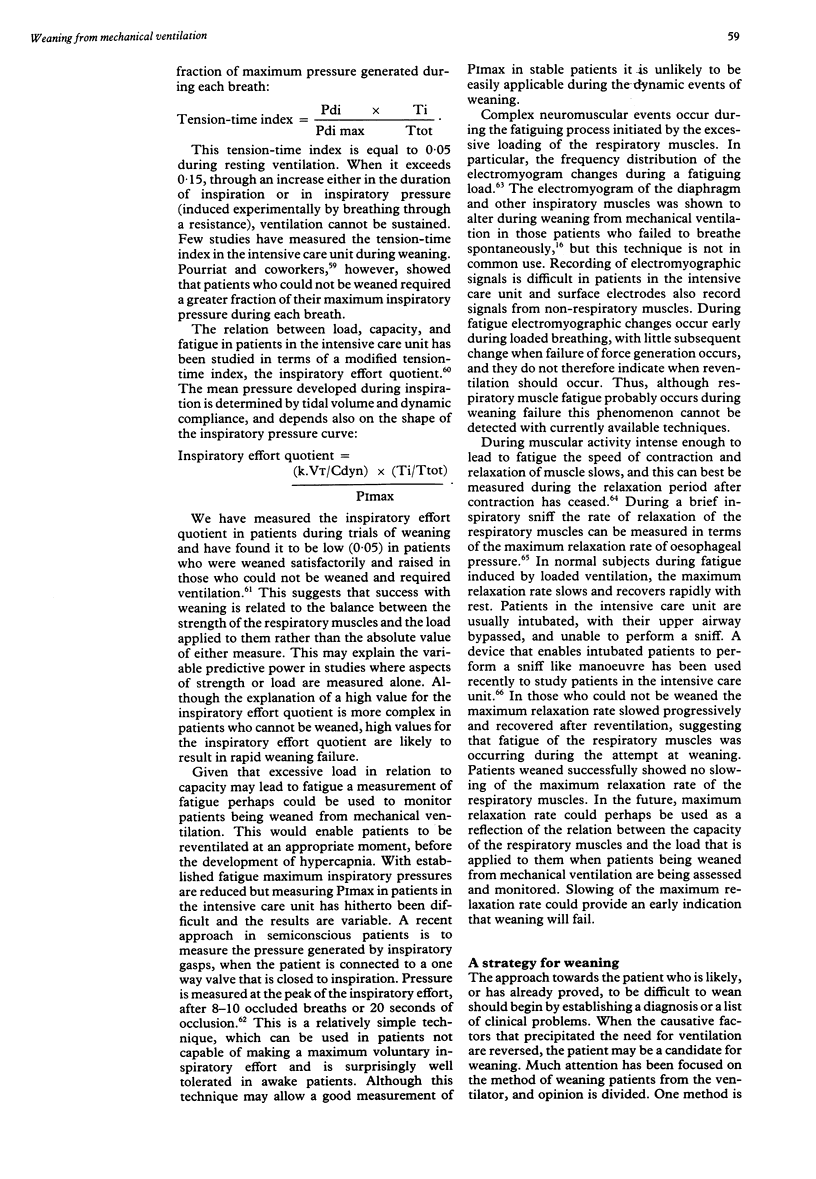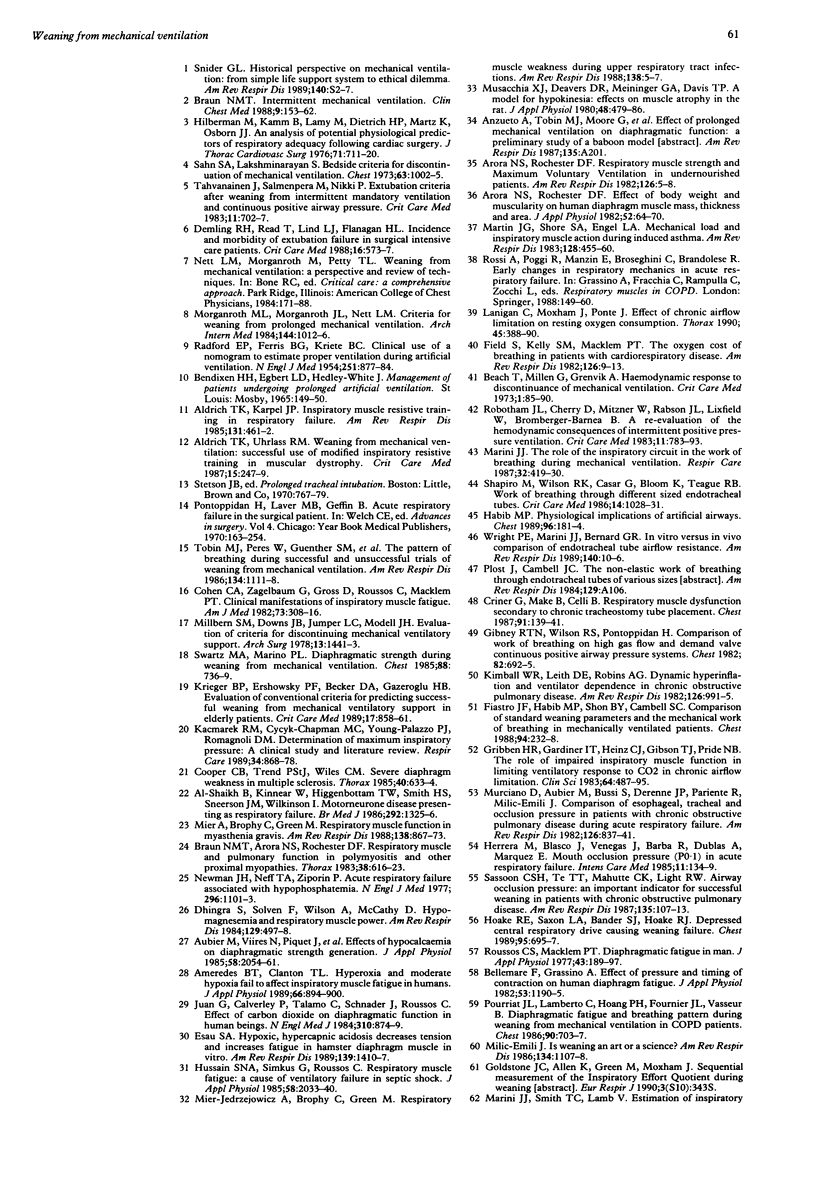Full text
PDF






Selected References
These references are in PubMed. This may not be the complete list of references from this article.
- Agusti A. G., Torres A., Estopa R., Agustividal A. Hypophosphatemia as a cause of failed weaning: the importance of metabolic factors. Crit Care Med. 1984 Feb;12(2):142–143. doi: 10.1097/00003246-198402000-00012. [DOI] [PubMed] [Google Scholar]
- Al-Shaikh B., Kinnear W., Higenbottam T. W., Smith H. S., Shneerson J. M., Wilkinson I. Motor neurone disease presenting as respiratory failure. Br Med J (Clin Res Ed) 1986 May 17;292(6531):1325–1326. doi: 10.1136/bmj.292.6531.1325. [DOI] [PMC free article] [PubMed] [Google Scholar]
- Aldrich T. K., Karpel J. P. Inspiratory muscle resistive training in respiratory failure. Am Rev Respir Dis. 1985 Mar;131(3):461–462. doi: 10.1164/arrd.1985.131.3.461. [DOI] [PubMed] [Google Scholar]
- Aldrich T. K., Uhrlass R. M. Weaning from mechanical ventilation: successful use of modified inspiratory resistive training in muscular dystrophy. Crit Care Med. 1987 Mar;15(3):247–249. [PubMed] [Google Scholar]
- Ameredes B. T., Clanton T. L. Hyperoxia and moderate hypoxia fail to affect inspiratory muscle fatigue in humans. J Appl Physiol (1985) 1989 Feb;66(2):894–900. doi: 10.1152/jappl.1989.66.2.894. [DOI] [PubMed] [Google Scholar]
- Arora N. S., Rochester D. F. Effect of body weight and muscularity on human diaphragm muscle mass, thickness, and area. J Appl Physiol Respir Environ Exerc Physiol. 1982 Jan;52(1):64–70. doi: 10.1152/jappl.1982.52.1.64. [DOI] [PubMed] [Google Scholar]
- Arora N. S., Rochester D. F. Respiratory muscle strength and maximal voluntary ventilation in undernourished patients. Am Rev Respir Dis. 1982 Jul;126(1):5–8. doi: 10.1164/arrd.1982.126.1.5. [DOI] [PubMed] [Google Scholar]
- Aubier M., Viires N., Piquet J., Murciano D., Blanchet F., Marty C., Gherardi R., Pariente R. Effects of hypocalcemia on diaphragmatic strength generation. J Appl Physiol (1985) 1985 Jun;58(6):2054–2061. doi: 10.1152/jappl.1985.58.6.2054. [DOI] [PubMed] [Google Scholar]
- Beach T., Millen E., Grenvik A. Hemodynamic response to discontinuance of mechanical ventilation. Crit Care Med. 1973 Mar-Apr;1(2):85–90. doi: 10.1097/00003246-197303000-00005. [DOI] [PubMed] [Google Scholar]
- Bellemare F., Grassino A. Effect of pressure and timing of contraction on human diaphragm fatigue. J Appl Physiol Respir Environ Exerc Physiol. 1982 Nov;53(5):1190–1195. doi: 10.1152/jappl.1982.53.5.1190. [DOI] [PubMed] [Google Scholar]
- Braun N. M., Arora N. S., Rochester D. F. Respiratory muscle and pulmonary function in polymyositis and other proximal myopathies. Thorax. 1983 Aug;38(8):616–623. doi: 10.1136/thx.38.8.616. [DOI] [PMC free article] [PubMed] [Google Scholar]
- Braun N. M. Intermittent mechanical ventilation. Clin Chest Med. 1988 Mar;9(1):153–162. [PubMed] [Google Scholar]
- Cohen C. A., Zagelbaum G., Gross D., Roussos C., Macklem P. T. Clinical manifestations of inspiratory muscle fatigue. Am J Med. 1982 Sep;73(3):308–316. [PubMed] [Google Scholar]
- Cooper C. B., Trend P. S., Wiles C. M. Severe diaphragm weakness in multiple sclerosis. Thorax. 1985 Aug;40(8):633–634. doi: 10.1136/thx.40.8.633. [DOI] [PMC free article] [PubMed] [Google Scholar]
- Criner G., Make B., Celli B. Respiratory muscle dysfunction secondary to chronic tracheostomy tube placement. Chest. 1987 Jan;91(1):139–141. doi: 10.1378/chest.91.1.139. [DOI] [PubMed] [Google Scholar]
- Demling R. H., Read T., Lind L. J., Flanagan H. L. Incidence and morbidity of extubation failure in surgical intensive care patients. Crit Care Med. 1988 Jun;16(6):573–577. doi: 10.1097/00003246-198806000-00001. [DOI] [PubMed] [Google Scholar]
- Dhingra S., Solven F., Wilson A., McCarthy D. S. Hypomagnesemia and respiratory muscle power. Am Rev Respir Dis. 1984 Mar;129(3):497–498. doi: 10.1164/arrd.1984.129.3.497. [DOI] [PubMed] [Google Scholar]
- Esau S. A., Bellemare F., Grassino A., Permutt S., Roussos C., Pardy R. L. Changes in relaxation rate with diaphragmatic fatigue in humans. J Appl Physiol Respir Environ Exerc Physiol. 1983 May;54(5):1353–1360. doi: 10.1152/jappl.1983.54.5.1353. [DOI] [PubMed] [Google Scholar]
- Esau S. A. Hypoxic, hypercapnic acidosis decreases tension and increases fatigue in hamster diaphragm muscle in vitro. Am Rev Respir Dis. 1989 Jun;139(6):1410–1417. doi: 10.1164/ajrccm/139.6.1410. [DOI] [PubMed] [Google Scholar]
- Fiastro J. F., Habib M. P., Shon B. Y., Campbell S. C. Comparison of standard weaning parameters and the mechanical work of breathing in mechanically ventilated patients. Chest. 1988 Aug;94(2):232–238. doi: 10.1378/chest.94.2.232. [DOI] [PubMed] [Google Scholar]
- Field S., Kelly S. M., Macklem P. T. The oxygen cost of breathing in patients with cardiorespiratory disease. Am Rev Respir Dis. 1982 Jul;126(1):9–13. doi: 10.1164/arrd.1982.126.1.9. [DOI] [PubMed] [Google Scholar]
- Gibney R. T., Wilson R. S., Pontoppidan H. Comparison of work of breathing on high gas flow and demand valve continuous positive airway pressure systems. Chest. 1982 Dec;82(6):692–695. doi: 10.1378/chest.82.6.692. [DOI] [PubMed] [Google Scholar]
- Gribbin H. R., Gardiner I. T., Heinz G. J., 3rd, Gibson G. J., Pride N. B. Role of impaired inspiratory muscle function in limiting the ventilatory response to carbon dioxide in chronic airflow obstruction. Clin Sci (Lond) 1983 May;64(5):487–495. doi: 10.1042/cs0640487. [DOI] [PubMed] [Google Scholar]
- Haake R. E., Saxon L. A., Bander S. J., Haake R. J. Depressed central respiratory drive causing weaning failure. Its reversal with doxapram. Chest. 1989 Mar;95(3):695–697. doi: 10.1378/chest.95.3.695. [DOI] [PubMed] [Google Scholar]
- Herrera M., Blasco J., Venegas J., Barba R., Doblas A., Marquez E. Mouth occlusion pressure (P0.1) in acute respiratory failure. Intensive Care Med. 1985;11(3):134–139. doi: 10.1007/BF00258538. [DOI] [PubMed] [Google Scholar]
- Hilberman M., Dietrich H. P., Martz K., Osborn J. J. An analysis of potential physiological predictors of respiratory adequacy following cardiac surgery. J Thorac Cardiovasc Surg. 1976 May;71(5):711–720. [PubMed] [Google Scholar]
- Hussain S. N., Simkus G., Roussos C. Respiratory muscle fatigue: a cause of ventilatory failure in septic shock. J Appl Physiol (1985) 1985 Jun;58(6):2033–2040. doi: 10.1152/jappl.1985.58.6.2033. [DOI] [PubMed] [Google Scholar]
- Juan G., Calverley P., Talamo C., Schnader J., Roussos C. Effect of carbon dioxide on diaphragmatic function in human beings. N Engl J Med. 1984 Apr 5;310(14):874–879. doi: 10.1056/NEJM198404053101402. [DOI] [PubMed] [Google Scholar]
- Kimball W. R., Leith D. E., Robins A. G. Dynamic hyperinflation and ventilator dependence in chronic obstructive pulmonary disease. Am Rev Respir Dis. 1982 Dec;126(6):991–995. doi: 10.1164/arrd.1982.126.6.991. [DOI] [PubMed] [Google Scholar]
- Koulouris N., Vianna L. G., Mulvey D. A., Green M., Moxham J. Maximal relaxation rates of esophageal, nose, and mouth pressures during a sniff reflect inspiratory muscle fatigue. Am Rev Respir Dis. 1989 May;139(5):1213–1217. doi: 10.1164/ajrccm/139.5.1213. [DOI] [PubMed] [Google Scholar]
- Krieger B. P., Ershowsky P. F., Becker D. A., Gazeroglu H. B. Evaluation of conventional criteria for predicting successful weaning from mechanical ventilatory support in elderly patients. Crit Care Med. 1989 Sep;17(9):858–861. doi: 10.1097/00003246-198909000-00002. [DOI] [PubMed] [Google Scholar]
- Lanigan C., Moxham J., Ponte J. Effect of chronic airflow limitation on resting oxygen consumption. Thorax. 1990 May;45(5):388–390. doi: 10.1136/thx.45.5.388. [DOI] [PMC free article] [PubMed] [Google Scholar]
- Marini J. J. Should PEEP be used in airflow obstruction? Am Rev Respir Dis. 1989 Jul;140(1):1–3. doi: 10.1164/ajrccm/140.1.1. [DOI] [PubMed] [Google Scholar]
- Martin J. G., Shore S. A., Engel L. A. Mechanical load and inspiratory muscle action during induced asthma. Am Rev Respir Dis. 1983 Sep;128(3):455–460. doi: 10.1164/arrd.1983.128.3.455. [DOI] [PubMed] [Google Scholar]
- Mier-Jedrzejowicz A. K., Brophy C., Green M. Respiratory muscle function in myasthenia gravis. Am Rev Respir Dis. 1988 Oct;138(4):867–873. doi: 10.1164/ajrccm/138.4.867. [DOI] [PubMed] [Google Scholar]
- Mier-Jedrzejowicz A., Brophy C., Green M. Respiratory muscle weakness during upper respiratory tract infections. Am Rev Respir Dis. 1988 Jul;138(1):5–7. doi: 10.1164/ajrccm/138.1.5. [DOI] [PubMed] [Google Scholar]
- Milic-Emili J. Is weaning an art or a science? Am Rev Respir Dis. 1986 Dec;134(6):1107–1108. doi: 10.1164/arrd.1986.134.6.1107. [DOI] [PubMed] [Google Scholar]
- Milic-Emili J., Ploysongsang Y. Respiratory mechanics in the adult respiratory distress syndrome. Crit Care Clin. 1986 Jul;2(3):573–584. [PubMed] [Google Scholar]
- Millbern S. M., Downs J. B., Jumper L. C., Modell J. H. Evaluation of criteria for discontinuing mechanical ventilatory support. Arch Surg. 1978 Dec;113(12):1441–1443. doi: 10.1001/archsurg.1978.01370240063010. [DOI] [PubMed] [Google Scholar]
- Morganroth M. L., Morganroth J. L., Nett L. M., Petty T. L. Criteria for weaning from prolonged mechanical ventilation. Arch Intern Med. 1984 May;144(5):1012–1016. [PubMed] [Google Scholar]
- Mostow S. R. Influenza--a preventable disease not being prevented. Am Rev Respir Dis. 1986 Jul;134(1):1–1. doi: 10.1164/arrd.1986.134.1.1. [DOI] [PubMed] [Google Scholar]
- Moxham J. Aminophylline and the respiratory muscles: an alternative view. Clin Chest Med. 1988 Jun;9(2):325–336. [PubMed] [Google Scholar]
- Murciano D., Aubier M., Bussi S., Derenne J. P., Pariente R., Milic-Emili J. Comparison of esophageal, tracheal, and mouth occlusion pressure in patients with chronic obstructive pulmonary disease during acute respiratory failure. Am Rev Respir Dis. 1982 Nov;126(5):837–841. doi: 10.1164/arrd.1982.126.5.837. [DOI] [PubMed] [Google Scholar]
- Musacchia X. J., Deavers D. R., Meininger G. A., Davis T. P. A model for hypokinesia: effects on muscle atrophy in the rat. J Appl Physiol Respir Environ Exerc Physiol. 1980 Mar;48(3):479–486. doi: 10.1152/jappl.1980.48.3.479. [DOI] [PubMed] [Google Scholar]
- Newman J. H., Neff T. A., Ziporin P. Acute respiratory failure associated with hypophosphatemia. N Engl J Med. 1977 May 12;296(19):1101–1103. doi: 10.1056/NEJM197705122961908. [DOI] [PubMed] [Google Scholar]
- Pepe P. E., Marini J. J. Occult positive end-expiratory pressure in mechanically ventilated patients with airflow obstruction: the auto-PEEP effect. Am Rev Respir Dis. 1982 Jul;126(1):166–170. doi: 10.1164/arrd.1982.126.1.166. [DOI] [PubMed] [Google Scholar]
- Pontoppidan H., Laver M. B., Geffin B. Acute respiratory failure in the surgical patient. Adv Surg. 1970;4:163–254. [PubMed] [Google Scholar]
- Pourriat J. L., Lamberto C., Hoang P. H., Fournier J. L., Vasseur B. Diaphragmatic fatigue and breathing pattern during weaning from mechanical ventilation in COPD patients. Chest. 1986 Nov;90(5):703–707. doi: 10.1378/chest.90.5.703. [DOI] [PubMed] [Google Scholar]
- RADFORD E. P., Jr, FERRIS B. G., Jr, KRIETE B. C. Clinical use of a nomogram to estimate proper ventilation during artificial respiration. N Engl J Med. 1954 Nov 25;251(22):877–884. doi: 10.1056/NEJM195411252512201. [DOI] [PubMed] [Google Scholar]
- Robotham J. L., Cherry D., Mitzner W., Rabson J. L., Lixfeld W., Bromberger-Barnea B. A re-evaluation of the hemodynamic consequences of intermittent positive pressure ventilation. Crit Care Med. 1983 Oct;11(10):783–793. doi: 10.1097/00003246-198310000-00005. [DOI] [PubMed] [Google Scholar]
- Roussos C. S., Macklem P. T. Diaphragmatic fatigue in man. J Appl Physiol Respir Environ Exerc Physiol. 1977 Aug;43(2):189–197. doi: 10.1152/jappl.1977.43.2.189. [DOI] [PubMed] [Google Scholar]
- Sahn S. A., Lakshminarayan S. Bedside criteria for discontinuation of mechanical ventilation. Chest. 1973 Jun;63(6):1002–1005. doi: 10.1378/chest.63.6.1002. [DOI] [PubMed] [Google Scholar]
- Sassoon C. S., Te T. T., Mahutte C. K., Light R. W. Airway occlusion pressure. An important indicator for successful weaning in patients with chronic obstructive pulmonary disease. Am Rev Respir Dis. 1987 Jan;135(1):107–113. doi: 10.1164/arrd.1987.135.1.107. [DOI] [PubMed] [Google Scholar]
- Shapiro M., Wilson R. K., Casar G., Bloom K., Teague R. B. Work of breathing through different sized endotracheal tubes. Crit Care Med. 1986 Dec;14(12):1028–1031. doi: 10.1097/00003246-198612000-00007. [DOI] [PubMed] [Google Scholar]
- Snider G. L. Historical perspective on mechanical ventilation: from simple life support system to ethical dilemma. Am Rev Respir Dis. 1989 Aug;140(2 Pt 2):S2–S7. doi: 10.1164/ajrccm/140.2_Pt_2.S2. [DOI] [PubMed] [Google Scholar]
- Swartz M. A., Marino P. L. Diaphragmatic strength during weaning from mechanical ventilation. Chest. 1985 Nov;88(5):736–739. doi: 10.1378/chest.88.5.736. [DOI] [PubMed] [Google Scholar]
- Tahvanainen J., Salmenperä M., Nikki P. Extubation criteria after weaning from intermittent mandatory ventilation and continuous positive airway pressure. Crit Care Med. 1983 Sep;11(9):702–707. doi: 10.1097/00003246-198309000-00006. [DOI] [PubMed] [Google Scholar]
- Vihko V., Salminen A., Rantamäki J. Exhaustive exercise, endurance training, and acid hydrolase activity in skeletal muscle. J Appl Physiol Respir Environ Exerc Physiol. 1979 Jul;47(1):43–50. doi: 10.1152/jappl.1979.47.1.43. [DOI] [PubMed] [Google Scholar]
- Williams H. M., Jr IMV and weaning. Chest. 1980 Dec;78(6):804–804. doi: 10.1378/chest.78.6.804. [DOI] [PubMed] [Google Scholar]
- Wright P. E., Marini J. J., Bernard G. R. In vitro versus in vivo comparison of endotracheal tube airflow resistance. Am Rev Respir Dis. 1989 Jul;140(1):10–16. doi: 10.1164/ajrccm/140.1.10. [DOI] [PubMed] [Google Scholar]


